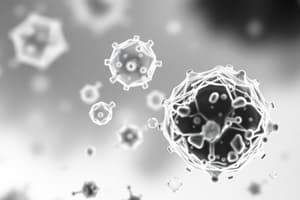Podcast
Questions and Answers
Which statement accurately contrasts race as a historical concept with the concept of a cline?
Which statement accurately contrasts race as a historical concept with the concept of a cline?
- Race accurately reflects continuous, gradual variations in human traits across geographic space, while clines categorize individuals into fixed groups based on superficial traits.
- Race classifies humans into fixed groups based on visible traits without genetic evidence, and clines represent continuous, gradual changes in traits over geographic space. (correct)
- Race acknowledges the influence of environmental factors on human variation, while clines are based solely on genetic differences between groups.
- Race is founded on genetic evidence and acknowledges the complexity of human variation, unlike clines which oversimplify diversity.
Franz Boas' research on the cephalic index among immigrant populations primarily challenged which aspect of racial classification?
Franz Boas' research on the cephalic index among immigrant populations primarily challenged which aspect of racial classification?
- The concept that environmental factors have no impact on human physical traits.
- The notion that racial categories are genetically determined and fixed. (correct)
- The belief that there is more genetic variation between populations than within them.
- The idea that genetic variation is continuous across geographic regions.
Richard Lewontin's genetic studies in the 1970s provided evidence against the biological validity of race by demonstrating that:
Richard Lewontin's genetic studies in the 1970s provided evidence against the biological validity of race by demonstrating that:
- Genetic differences between races are insignificant compared to variation within races. (correct)
- Environmental factors are more important than genetics in determining human traits.
- Racial categories accurately reflect underlying genetic clusters.
- Most human genetic variation occurs between different racial groups.
How do clines offer a more accurate representation of human biological variation compared to racial categories?
How do clines offer a more accurate representation of human biological variation compared to racial categories?
During which stage of the human growth cycle does rapid brain development and organ formation primarily occur?
During which stage of the human growth cycle does rapid brain development and organ formation primarily occur?
Which biological milestone primarily characterizes the postnatal stage of the human growth cycle?
Which biological milestone primarily characterizes the postnatal stage of the human growth cycle?
Grandmothers contributing to the survival of grandchildren exemplifies an evolutionary benefit during which stage of the human growth cycle?
Grandmothers contributing to the survival of grandchildren exemplifies an evolutionary benefit during which stage of the human growth cycle?
How does developmental adaptation differ from genetic adaptation in human populations?
How does developmental adaptation differ from genetic adaptation in human populations?
Which of the following scenarios exemplifies acclimatization in response to environmental stress?
Which of the following scenarios exemplifies acclimatization in response to environmental stress?
How do humans maintain homeostasis in response to environmental changes?
How do humans maintain homeostasis in response to environmental changes?
Which adaptation is a physiological response to heat stress in humans?
Which adaptation is a physiological response to heat stress in humans?
How does vasoconstriction aid in maintaining homeostasis in cold environments?
How does vasoconstriction aid in maintaining homeostasis in cold environments?
How does solar radiation relate to the evolution of human skin color?
How does solar radiation relate to the evolution of human skin color?
What is the primary role of vitamin D synthesis in human adaptation to different environments?
What is the primary role of vitamin D synthesis in human adaptation to different environments?
Which physiological adaptation is typically observed in populations living at high altitudes?
Which physiological adaptation is typically observed in populations living at high altitudes?
What are the health consequences associated with undernourishment in humans?
What are the health consequences associated with undernourishment in humans?
How does overnourishment impact human health?
How does overnourishment impact human health?
What principle does Wolff's Law describe?
What principle does Wolff's Law describe?
According to Wolff's Law, how do bones respond to increased physical stress, such as weight-bearing exercise?
According to Wolff's Law, how do bones respond to increased physical stress, such as weight-bearing exercise?
How does human adaptability contribute to evolutionary success?
How does human adaptability contribute to evolutionary success?
How did early racial classification systems primarily categorize human diversity?
How did early racial classification systems primarily categorize human diversity?
What was a key argument made by W.E.B. Du Bois regarding health disparities?
What was a key argument made by W.E.B. Du Bois regarding health disparities?
Which statement best describes a genetic adaptation?
Which statement best describes a genetic adaptation?
What characterizes a developmental adaptation?
What characterizes a developmental adaptation?
Which example illustrates a cultural adaptation to environmental conditions?
Which example illustrates a cultural adaptation to environmental conditions?
During the prenatal stage of the human growth cycle, what significant biological event takes place?
During the prenatal stage of the human growth cycle, what significant biological event takes place?
Which of the following describes a key feature of the postnatal stage?
Which of the following describes a key feature of the postnatal stage?
What evolutionary role is associated with grandmothers in the adult stage of the human growth cycle?
What evolutionary role is associated with grandmothers in the adult stage of the human growth cycle?
According to Allen's Rule, how do humans adapt to hot environments concerning limb length?
According to Allen's Rule, how do humans adapt to hot environments concerning limb length?
What does Bergmann's Rule suggest regarding body shape adaptations to cold environments?
What does Bergmann's Rule suggest regarding body shape adaptations to cold environments?
Flashcards
Is Race Biologically Valid?
Is Race Biologically Valid?
Not a biologically valid concept due to its failure to accurately describe human genetic diversity. Human variation is better understood as a continuum of clinal variation.
What is a Cline?
What is a Cline?
Gradual variation of traits across geographic locations, showing continuous change rather than sharp divisions.
Richard Lewontin's Genetic Research
Richard Lewontin's Genetic Research
Showed that most human variation occurs within populations rather than between them, challenging racial categories.
Genetic Adaptation
Genetic Adaptation
Signup and view all the flashcards
Developmental Adaptation
Developmental Adaptation
Signup and view all the flashcards
Acclimatization
Acclimatization
Signup and view all the flashcards
Cultural Adaptation
Cultural Adaptation
Signup and view all the flashcards
Prenatal Stage
Prenatal Stage
Signup and view all the flashcards
Postnatal Stage
Postnatal Stage
Signup and view all the flashcards
Adult Stage
Adult Stage
Signup and view all the flashcards
Homeostasis
Homeostasis
Signup and view all the flashcards
Heat Adaptations
Heat Adaptations
Signup and view all the flashcards
Cold Adaptations
Cold Adaptations
Signup and view all the flashcards
Skin Color Adaptations
Skin Color Adaptations
Signup and view all the flashcards
High-Altitude Adaptations
High-Altitude Adaptations
Signup and view all the flashcards
Undernourishment
Undernourishment
Signup and view all the flashcards
Overnourishment
Overnourishment
Signup and view all the flashcards
Wolff's Law
Wolff's Law
Signup and view all the flashcards
Physical Activity Benefits
Physical Activity Benefits
Signup and view all the flashcards
Human Adaptability Importance
Human Adaptability Importance
Signup and view all the flashcards
Historical Racial Classifications
Historical Racial Classifications
Signup and view all the flashcards
Franz Boas' Contributions
Franz Boas' Contributions
Signup and view all the flashcards
W.E.B. Du Bois' Argument
W.E.B. Du Bois' Argument
Signup and view all the flashcards
Clines
Clines
Signup and view all the flashcards
Genetic Adaptation Details
Genetic Adaptation Details
Signup and view all the flashcards
Developmental Adaptation Details
Developmental Adaptation Details
Signup and view all the flashcards
Acclimatization Details
Acclimatization Details
Signup and view all the flashcards
Prenatal Stage Events
Prenatal Stage Events
Signup and view all the flashcards
Postnatal Stage Events
Postnatal Stage Events
Signup and view all the flashcards
Adult Stage Events
Adult Stage Events
Signup and view all the flashcards
Study Notes
Race as a Biological Concept
- Race is not a biologically valid concept due to its inaccurate representation of human genetic diversity.
- Human diversity is better understood as a continuum of clinal variation, showing gradual changes across geographic regions.
- Race is a social construct that oversimplifies human biological diversity.
- Early racial classifications, such as those by Linnaeus and Blumenbach, relied on traits like skin color and hair type.
- These classifications lacked genetic evidence and ignored the complexity of human variation.
- Franz Boas' research on the cephalic index showed head shape changes based on environmental conditions, challenging fixed racial differences.
- W.E.B. Du Bois argued health disparities were due to social rather than biological factors.
- Richard Lewontin found that about 85% of genetic variation exists within populations, not between racial groups.
- Clines are gradual changes in genetic traits over geographic space, reflecting continuous human variation influenced by environment.
Clinal Variation
- Clinal variation replaced race in understanding biological variation due to key 20th-century discoveries.
- Boas’ studies on head shape changes in immigrant populations demonstrated environmental influence.
- Lewontin’s genetic research in the 1970s highlighted greater variation within populations than between them.
Human Growth Cycle Stages
- Prenatal stage spans from conception to birth, marked by brain development and organ formation.
- Postnatal stage spans from birth to adulthood, with rapid growth, motor skills development, and sexual dimorphism.
- Adult stage includes maturation, reproduction, aging, and senescence.
- Grandmothers contribute to evolutionary success through social support for grandchildren.
Types of Adaptation
- Genetic adaptation involves long-term evolutionary changes due to environmental pressures.
- Developmental adaptation occurs during an individual’s growth due to environmental factors.
- Acclimatization refers to short-term physiological adjustments to environmental stress.
- Cultural adaptation involves adjustments using behavior or technology.
Genetic Adaptation
- This occurs over generations.
- It involves changes in allele frequencies in a population due to environmental pressures.
- Skin color adaptations to UV radiation is one such example.
Developmental Adaptation
- This occurs during an individual's growth
- It is non-heritable but is influenced by environmental factors.
- The larger chest size in high-altitude populations to accommodate more efficient breathing, is an example.
Acclimatization
- This is a short-term, reversible physiological adjustment to environmental conditions.
- It occurs during an individual’s life.
- An example is increased red blood cell production to accommodate high altitudes.
Cultural Adaptation
- Involves adjustments in behavior or technology.
- The use of clothing or air conditioning to cope with heat, is an example.
Homeostasis
- Humans maintain homeostasis through thermoregulation, hydration, oxygen regulation, and nutrition.
Adaptations to Heat
- Adaptations include sweating and vasodilation to cool the body.
- Allen’s rule suggests longer limbs for heat dissipation.
Adaptations to Cold
- Adaptations include vasoconstriction and increased metabolic rate to conserve heat.
- Bergmann’s rule suggests stockier body shapes to conserve heat.
High-Altitude Adaptations
- Adaptations include increased lung capacity and red blood cell production to cope with low oxygen.
- Short-term acclimatization includes faster breathing and increased heart rate.
- Long-term genetic adaptations include larger chest size.
Solar Radiation and Skin Color
- Darker skin evolved in high UV radiation areas to protect against sun damage and folate degradation.
- Lighter skin evolved in low UV regions to maximize vitamin D production for bone health.
- Folate is essential for fetal development, and UV radiation can degrade it, thus dark skin is beneficial in these regions.
- Lighter skin helps produce vitamin D in low-UV areas, which is necessary for calcium absorption and bone health.
Nutrition and Human Health
- Undernourishment leads to stunted growth, weakened immune systems, and delayed development.
- Overnourishment results in obesity, cardiovascular diseases, and type 2 diabetes.
Wolff's Law
- Wolff’s Law states bones remodel in response to physical stress, becoming stronger where stress is applied.
- Athletes in weight-bearing activities develop stronger bones due to this principle.
Human Adaptability Implications
- Human adaptability is crucial for survival in diverse environments through genetic, physiological, and cultural adaptations.
- Adaptations increase the likelihood of survival and reproductive success.
- Adaptations like thermoregulation and fat storage enhance survival and reproductive success in varied climates.
Studying That Suits You
Use AI to generate personalized quizzes and flashcards to suit your learning preferences.




